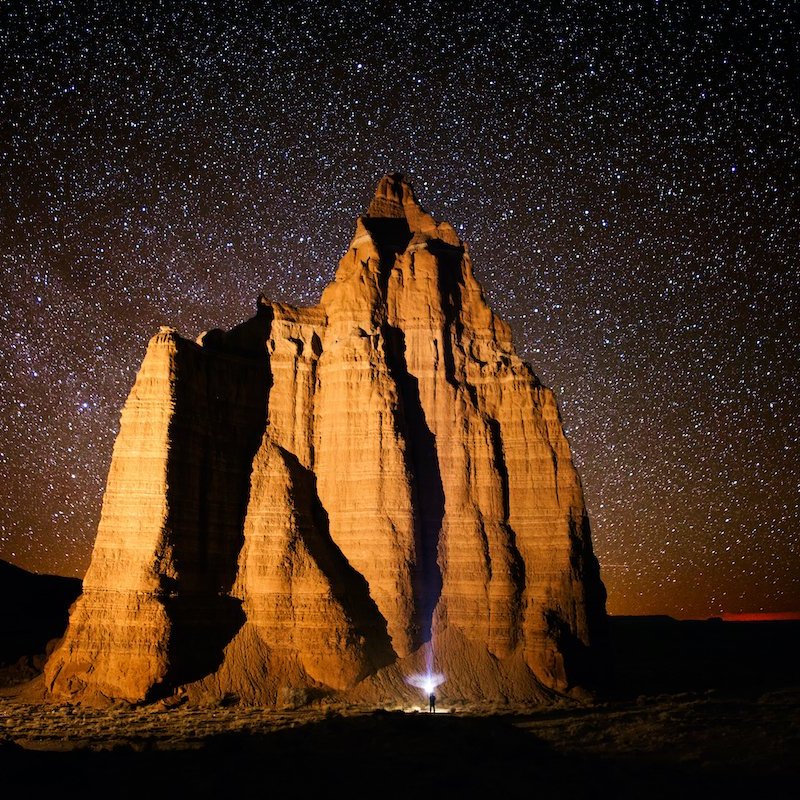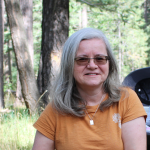
Photo Credit: Quinn Calder / Shutterstock.com
I’ve never seen the night sky as clear, as beautiful as during my first camping trip through the Southwest. The first night we camped in Petrified Forest National Park in Arizona, I noticed the Milky Way stretching across the sky, filled with millions of stars.
Videos by TravelAwaits
The American Southwest, including the states of Arizona, New Mexico, and parts of Utah, Colorado, and California, is mostly desert. It includes the Sonoran, Chihuahuan, and Mojave deserts and the Colorado Plateau. The dry, crisp air here makes the skies clearer since the water particles that define humidity amplify light pollution. Adding long stretches of areas with no urban development to the low humidity makes the Southwest one of the best places for stargazing.
Even here though, as urban development spreads, truly dark skies are becoming less common. But you can always find them in National Parks. Protecting nature and historical sites ensures no developments within the parks, which makes them perfect for dark skies. Today, there are over 20 International Dark-Sky Certified Parks in the country, and over half of them in the Southwest. Below, I compiled a list of my favorite Dark Sky National Parks in the Southwest.
1. Chaco Culture National Historical Park
New Mexico
A Dark Sky Certified park since 2013, Chaco Culture National Historical Park in New Mexico made the protection of dark skies a priority for years, not only for its visitors but also for the natural environment.
Home of a plethora of ruins, built between 850 and 1250 A.D. by the Ancestral Puebloan civilization, Chaco protects some amazing archaeological sites. Ancient Chacoans were expert astronomers, and their structures reflect this, as they are often aligned with cyclical patterns of the celestial objects.
The park continues this commitment to astronomy, being the only national park with its own observatory, where visitors can look up to the same star-filled sky as ancient Chacoans did thousands of years ago. Chaco also offers special night sky programs, emphasizing the similarities and differences between the way people viewed the night sky in ancient times and today.
To make attending night programs easy, and ensure you can see the incredible night sky, camp in the park at the campground near Gallo Wash, where you’ll be surrounded by cliffs and boulders, petroglyphs, and a cliff dwelling.

(Photo Credit: Kris Wiktor / Shutterstock.com)
2. Canyonlands National Park
Utah
Canyonlands National Park in Utah, featuring a gorgeous landscape filled with red rock formations, canyons, and buttes, still remains one of the least visited of Utah’s parks near Moab.
Carved by the Colorado River and its tributaries, the rivers divide the park into four districts. Island in the Sky offers the easiest access through a winding road studded with viewpoints of gorgeous rock formations and canyons. The Needles, named after the spiral rock formations that dominate the area, offers great hiking trails. The Maze, the least accessible area of the park, is crisscrossed by backcountry trails. The fourth district is defined by the Colorado and Green Rivers.
Explore the park during the day hiking through the incredible landscape, then camp here for an opportunity for stargazing against its backdrop. A Certified Dark Sky Park since 2015, Canyonlands features some of the darkest skies you can find. To enjoy them, camp in one of the two campgrounds, either in the Island in the Sky or in the Needles district.
3. Capitol Reef National Park
Utah
Capitol Reef National Park in Utah features some of the darkest skies on the planet. One of the least-visited parks in the state, Capitol Reef offers a landscape filled with cliffs, canyons, domes, and ridges with miles of hiking trails to explore.
The park offers a great opportunity to learn about geology as part of the Waterpocket Fold, a nearly 100-mile warp in the earth’s crust, a change of elevation between two layers. Of course, you don’t need to know this to enjoy the incredible landscape.
Spend the day exploring the park, and stay the night in one of the campgrounds for a stargazing experience in some of the darkest skies. The park offers a large, developed campground, with 71 sites, plus a few primitive ones, so you have plenty of opportunities to enjoy the overnight experience.

(Photo Credit: Michael Sherman / Shutterstock.com)
4. Bryce Canyon National Park
Utah
Another great place for dark skies, Bryce Canyon National Park in Utah is a place of wonder. Home of the largest concentration of hoodoos anywhere in the world, the park is a popular destination for outdoor enthusiasts. Hiking opportunities abound here, ranging from easy strolls on the rim to long and strenuous hikes down into the canyon and back, surrounded by hoodoos of all shapes and sizes.
As enjoyable as Bryce Canyon is during the day, staying here overnight adds a whole other dimension to the experience. Staying at the Lodge or camping within the park’s boundaries offers opportunities to walk outside to the rim of the canyon, where you can look up into a clear, star-filled sky.
During the yearly astronomy festivals in late June, the park hosts stargazing, both evening programs and night-time telescope viewing, on the rim between Sunrise and Sunset Point. Check the park’s website for specifics, or stop at the Visitor Center when you are at the park for more information.
5. Hovenweep National Monument
Colorado, Utah
Hovenweep National Monument in the Four Corners region, on the Colorado-Utah border, preserves ruins built by the Ancestral Puebloans between 1166 and 1277 A.D. True to its name, meaning “deserted valley”, Hovenweep is in a desolate area of the Southwest. With structures in both Utah and Colorado, the park is far from any town in either state. We enjoy visiting the park, not only for its ruins but for its remoteness.
The easiest way to explore Hovenweep is by walking the Square Tower Group Trail, starting at the Visitor Center. You’ll walk on both rims of Little Ruins Canyon, crossing it at one point. The ancient structures, including square and rounded towers, are both on the rims and inside the canyon.
Designated an International Dark Sky Park in 2015, the Hovenweep offers amazing stargazing opportunities. To enjoy the night sky, stay overnight at the campground on the rim near the Visitor Center.

(Photo Credit: Beth Ruggiero-York / Shutterstock.com)
6. Sunset Crater, Wupatki, And Walnut Canyon
Arizona
The Flagstaff Area National Monuments in Arizona are all dark sky places, worth exploring not only during the day but walking outside to watch the dark skies at night, too.
The Bonito Campground near Sunset Crater Volcano National Monument offers overnight stays and the perfect opportunity to enjoy the dark night sky. Though the area was scorched by fire in April 2022, the campground is set to reopen in mid-May. The campsites may offer less shade during the day, but the skies are still just as dark at night.
During the day, enjoy views of Sunset Crater, which showcases colors reminiscent of a gorgeous Arizona sunset. Drive the scenic loop to explore the area and stop at Wupatki National Monument, which preserves ancient ruins of people who lived here a thousand years before us.
Editor’s Note: The National Park Service announced on August 18, 2022 that the Sunset Crater Volcano is partially open with limited services following the Tunnel Wildfire destruction. The Lava Flow and A’a trails are open. The Visitor Center, Lenox Crater and Lava’s Edge Trails, as well as the Cinder Hills Overlook remain closed. For the most up-to-date information, please visit NPS.gov.Or drive over to Walnut Canyon National Monument on the other side of Flagstaff, Enjoy a hike into the canyon through ancient cliff dwellings or a leisurely stroll on the rim with views of the canyon while exploring the park.
Camping overnight at Sunset Crater offers the best opportunity to enjoy the dark night sky. At the right time, you might catch astronomy events set up in front of the Visitor Center. Astronomy clubs from Flagstaff and other parts of Arizona host star parties here, pointing multiple telescopes at different sites in the sky, offering views and stories about celestial objects. Besides seeing the gorgeous night sky, clear from light pollution, a star party like this is an exceptional learning experience.

(Photo Credit: Alexey Suloev / Shutterstock.com)
7. Grand Canyon National Park
Arizona
Home of the most famous landmark in the Southwest, one of the seven natural wonders of the world, the Grand Canyon National Park in Arizona is visited by millions annually. The gorgeous landscape of the immense canyon is what attracts everyone here, but the night sky is just as spectacular.
The South Rim, the most visited site, offers opportunities for leisurely walks along the rim, hiking into the canyon, biking, or taking a tour. However, the more remote North Rim offers a quieter environment, when open, during the summer season.
Designated a Dark Sky Park, the canyon offers plenty of opportunities for stargazing. In early June, different astronomy clubs from the state host eight-day-long annual star parties on both the South and North Rims. They include slide shows, constellation tours, and telescope viewing.
To enjoy the night skies, you can camp or stay in a hotel at the South Rim. The North Rim offers cabins, but you need to book well in advance.

(Photo Credit: Arthur Cauty / Shutterstock.com)
8. Arches National Park
Utah
One of Utah’s “Mighty Five,” Arches National Park is known for its incredible rock formations, especially for its natural sandstone arches. Over 2,000 known natural arches lay scattered in this landscape, including the famous Delicate Arch. Other rock formations, balanced rocks, rock fins, and columns offer more variety, their red sandstone in stark contrast with the clear blue skies of the high desert. You have no shortage of things to do while spending a day here.
Yet enjoying this wonderland of rocks during the day is only one highlight of a visit. Arches is also a certified Dark Sky Park, with a campground in the middle of one of the highest concentrations of rock formations in Devils Garden. If you camp here, walk out in the middle of the night for incredible stargazing opportunities.
9. Petrified Forest National Park
Arizona
I will end with the National Park that started it all for me. As I mentioned in the beginning, my first encounter with the darkest skies in the Southwest was in the early 1990s at Petrified Forest National Park in Arizona. Camping under the stars in a remote corner of the state, I saw the Milky Way clearer than I’ve ever seen it before.
Protecting a large area of the beautiful, if barren Painted Desert, filled with petrified logs that used to be a lush rainforest millions of years ago, visiting Petrified Forest National Park offers an experience unlike any other. Wood logs turned to stone lay scattered through the park, while the colors of the Painted Desert showcase an otherworldly landscape.
You won’t find designated camping sites in the park, though a few wilderness campsites are within a mile of certain parking lots. Another option is just outside the park’s boundaries, in the parking lots of the gift shops, where they allow self-contained camping.
Get The Most Out Of Your Southwest Stargazing
For the best experiences, check each park’s website, focusing on events, to see when they hold stargazing nights, telescope viewings, or talks about the night sky.
When viewing the stars and other celestial objects in a dark sky place, give yourself at least 20 minutes to adjust to the dark. During this time, don’t turn your phone or any flashlight on. If you need to use a flashlight, use a red filter on it.
Wear warm clothing, even on summer nights, since in the desert the temperature changes drastically between day and night. Look for constellations and other stargazing opportunities, too.
Related Reading:
